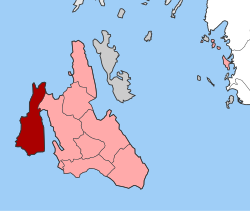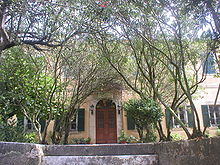Lixouri
|
Parish of Paliki (Lixouri) Δημοτική Ενότητα Παλικής (Παλική (Λιξούρι)) |
||
|---|---|---|
|
|
||
| Basic data | ||
| State : |
|
|
| Region : |
Ionian islands
|
|
| Regional District : | Kefallinia | |
| Municipality : | Kefalonia | |
| Geographic coordinates : | 38 ° 12 ' N , 20 ° 26' E | |
| Height above d. M .: | 410 m Ø community |
|
| Area : | 119.341 km² | |
| Residents : | 7,098 (2011) | |
| Population density : | 59.5 inhabitants / km² | |
| Code No .: | 350106 | |
| Structure: |
1 city district 14 local communities |
|
| Website: | www.paliki.gr | |
| Location in the municipality of Kefalonia and in the regional unit of Kefallinia | ||
Lixouri ( Greek Ληξούρι ( n. Sg. ) Formerly also Lissuri ) is the second largest city on the island of Kefalonia and has 7098 inhabitants (as of 2011). The city has an important port as well as a philharmonic hall and a college for instrument making. Lixouri is located near the ancient city of Pale ( Πάλη ) on the Paliki peninsula (Italian: Palacchi).
From 1997 to 2010 Lixouri was a synonym and center of the municipality (dimos) Paliki, which was merged with the administrative reform in 2010 in the newly created municipality of Kefalonia , in which it has since formed a municipality with 7098 inhabitants.
geography
Lixouri is located on the west side of the gulf of the same name on the Paliki peninsula, which encompasses the entire urban area. The main town itself is in a valley, the west is very mountainous. Sulfur springs rose north and south of Lixouri and have now dried up. The hilly landscape was used for growing raisins for centuries.
history
The ancient city of Pali or Pale ( Πάλη ) was already mentioned by Pausanias , but never gained great importance in ancient times. Lixouri was built at its gates and completely replaced it in the Middle Ages, as it has a port. Lixouri was first mentioned in 1534 in a letter to the Senate of Venice . Around 1800 Lixouri was not only the Catholic bishopric, but also the seat of the regional court and the health authority. At that time the city had 5,000 inhabitants, making it as large as Argostoli, which was the administrative seat of the island during the Republic of the Ionian Islands . During this time, the tertiary deposits and fossil finds were also discovered. In 1836 the Pale Philharmonic School was founded, following the tradition of the Ionian School .
The city became widely known in 19th century Greece as the home of satirical author Andreas Laskaratos , as many of his stories are set here. At the same time she was a stop on numerous tours of Greece, such as "A Tour in Greece" by Richard Ridley Farrer or "A History of Greece" by George Finlay in 1867.
Lixouri was hit by a tsunami on September 20, 1867, and there was also great destruction in an earthquake on January 23, 1867. A total of 1000 buildings were destroyed - according to another source, all of the houses except 12, which are now uninhabitable. 200 residents were slain.
The pianist Dora Wihan (née Weis), the wife of the Czech cellist Hanuš Wihan, lived and worked in Lixouri . After a trip to America in 1887, she settled there and stayed there until 1891. Richard Strauss had a love affair with her and visited the city many times.
On December 8, 1966, the Heraklion , a ship belonging to the Typaldosnahe shipping company from Lixouri, sank near Falkonera . 241 people lost their lives in the accident. The majority of the drowned staff came from Lixouri, many families had victims to complain about and most of them also refused to accept the small amount of compensation. The long-established Typalpos family, who come from the Neapolitan aristocratic Tirpado family, suffered damage to their image that also affected bystanders.
The largest earthquake in recent history was the 1953 earthquake . It destroyed almost the entire structure of the island (the northern part remained almost intact) and led to massive emigration. Thanks to strict building regulations, no earthquake has caused major damage since then. The hospital was rebuilt with a monetary and material donation from the Church of Sweden and a monetary donation from the Ethiopian Emperor Haile Selassie .
After years of emigration and stagnation, a steady increase in the population has been recorded since 1990. In the late 1990s, the city gradually merged with the other localities on the Pali peninsula. Since then, the official name of the city has been Dimos Palikis . In everyday life (for example in correspondence or in shipping) the name Lixouri is still used and is also used for the other localities. Numerous cultural events and folk festivals take place, especially in August. The best known is the wine festival in Mantzavinata .
Lixouri in literature
- Death of a City (1954) by Kay Cicellis describes the events of the 1953 earthquake in Lixouri
- Iphigenia in Lixourion , a play (1956) by Petros Katsaitis
- The Varied Airs of Spring (1969) by Ilka Chase ends in Lixouri
- A la recherche du rameau d'or (1976) by Georges Haldas
Cityscape and landmarks
After the earthquake of 1953, the city was largely rebuilt according to the old floor plan, contrary to the advice of town planners. Churches and some important structures (which were often only slightly damaged) were rebuilt. However, the town hall and the Markato market building , previously a symbol of the city, were demolished. On the main square with the large rubber tree, the Plateia , there are coffee houses and the Mavroidis pastry shop, founded in 1922. The eastern narrow side of the square forms the harbor and leads to the promenade, where there are more cafes and restaurants.
In 2003 the municipality decided to rebuild the square. The New Markato has been built and is now a theater and has some shops on the ground floor. Towards the Plateia, the previous row of shops was demolished in favor of two gatehouses. These create an architectural transition from the theater to the lively square, which, as in all Greek cities, plays a key role in urban life. This is where friends and strangers meet, and this is where performances and events take place.
The following sights are spread all over the city and are often easily reached on foot.
Sights in the city center
- School building at the harbor : The building with the characteristic ribbon windows is an important testimony to classical modernism and was built in 1933 under the state school building program headed by the architect Patroklos Karantinos . After it was no longer allowed to be used as a school due to structural defects, it was used as a warehouse for the city administration. In 2016 it was externally restored as an architectural monument.
- Pantocrator Church
- Monument to Andreas Laskaratos and monument to the navigator on the beach promenade
- few ruins of the ancient city of Pale (Pali)
- Iakovatios Library : The classicist villa from 1866 of the Tirpado / Typaldos family was donated to the state and is open to the public. Objects from the history of the family are exhibited and the library of the church historian Hamilcar S. Alivizatos is displayed in showcases . According to the specifications of the donors, a public lending library is operated, which is located in the former kitchen and functions as the city library. The building, with its preserved floors, ceilings and furniture, is a prime example of classicism in the Ionian Islands. A visit is currently only possible by appointment.
Sights in the suburbs
- Church of St. Marina with ornate icon shrine in Soullaroi (badly damaged in 2014)
- Classicist ancestral home of the Danelatos family in Damoulianata
- In Mantzavinata : Church of St. Spyridon (long nave basilica)
- Bell tower of the church of St. Paraskevi in Atheras made of sandstone, and the former monastery of St. Spyridon on the beach there
- Baroque church from 1620 of Maria Doloroza (Ιερός Ναός Παναγίας Ρόγγων) in Monopolata
- Grotto Church of St. Paraskevi in Lepeda
nature
- Kounopetra (rocking stone) on the cape of the same name.
- Beaches XI, Petani and Mania with a steep wall.
- A popular destination is the Kipouria Monastery because of its beautiful views and sunsets.
education
The Lixouri Philharmonic Orchestra is known nationwide and regularly gives concerts throughout the year and also goes on tour abroad.
The TEI Ionion Nison (FH of the Ionian Islands) maintains the business administration and acoustics / musical instrument making departments on the Lixouri campus. All the important authorities have branches on site, such as the prefecture's vehicle registration office, post office, telecom and the electricity supplier. There is a hospital, an old people's home, a theater and various sports facilities.
traffic
Lixouri is also a small town by Greek standards, as a student town in winter and seasonal accommodation in summer it is very lively. Therefore there is a good ferry connection to Argostoli ( every hour / half hour) and to the mainland. KTEL bus connections exist to Patras and Athens. Since 2006 there has been a bypass road, on which the new sports field is also located.
sons and daughters of the town
- Elias (Èlie) Meniates (1669–1714), polymath and university professor in Venice
- Vikentios Damodos (1700–1752), philosopher of the Enlightenment
- Angelo Zulatti (1732–1798), doctor and Giovanni Francesco Zulatti (1762–1805), doctor and composer.
- Andreas Laskaratos (1811–1901), satirical poet and writer
- Georgios Avlichos (1842–1909), painter
- Georgios Bonanos (1863–1940), sculptor of historicism
- Marinos Geroulanos (1867–1960), surgeon, professor in Greifswald and Kiel
- Hamilcar S. Alivizatos (1887–1969), church historian
- Spyridon Marinatos (1901–1974), important archaeologist, excavator of the Minoan city of Akrotiri on the island of Santorini
- Antiochos Evangelatos (1903–1981), conductor and composer
| Atheras | ||
| Chavriata |

|
Argostoli |
| Cape Kounopetra | Mantzavinata |
Districts
Under the name Dimos Palikis, Lixouri and small localities are grouped together to form a district of the municipality of Kefalonia. The highlighted locations have the status of a locality, the rest are administratively co-administered by others or are partially even geographically merged with them.
|
|
|
Note: The district of Matzavinata also includes the village of Soullaroi, the settlement of Kounopetra and the island of Vardiani and therefore bears the official name Katogi (roughly 'lower valley').
Individual evidence
- ↑ Results of the 2011 census at the National Statistical Service of Greece (ΕΛ.ΣΤΑΤ) ( Memento from June 27, 2015 in the Internet Archive ) (Excel document, 2.6 MB)
- ^ Conrad Bursian: Geography of Greece, p. 373. BG Teubner, 1868
- ^ Bernhard Abend, Birgit Borowski, Achim Bourmer: Baedeker Korfu, Ionische Insel p. 157, 2005
- ↑ D. Reimer: Journal of the Society for Geography in Berlin. P. 271, 1868
- ↑ Chronik der Freya 1868, p. 231
- ↑ Michael Kennedy: Richard Strauss: Man, Musician, Enigma, p. 54
Web links
- Official website of the city
- Lixouri.net Commercial page with travel information ( Memento of January 3, 2006 in the Internet Archive )
- Site of the Lixouri campus of the University of Applied Sciences of the Ionian Islands ( memento of February 2, 2009 in the Internet Archive )





